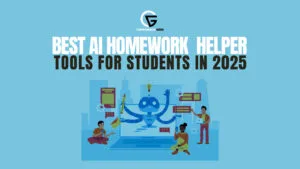Did you know that over 70% of students now use AI tools for homework assistance? AI-powered learning is no longer the future—it’s the present. In today’s fast-paced academic world, where deadlines loom like shadows, students are constantly seeking an extra edge. Enter AI homework helpers—smart, intuitive tools designed to tackle everything from complex equations to essay structuring. These AI-powered study partners are not only highly intelligent but also available 24/7, transforming the way students learn. By 2025, these tools will be essential for students worldwide, making homework easier, faster, and more personalized than ever. Let’s explore the best AI tools that are reshaping education and making learning more efficient and stress-free.
Table of Contents
ToggleThe Rise of AI in Education
Understanding the Growing Role of AI
Artificial Intelligence (AI) is becoming a significant part of education. It’s not just a trend; it’s a revolution. Schools and universities are integrating AI tools to enhance learning experiences. But what does this mean for students? With an AI homework helper, students can receive instant explanations, personalized study support, and step-by-step solutions, making learning more accessible and efficient than ever before.
AI can analyze vast amounts of data to help educators understand student learning patterns. By identifying trends that might go unnoticed, AI can pinpoint specific areas where a student struggles, allowing teachers to tailor their approach for better learning outcomes.
Personalized Study Experiences
One of AI’s biggest advantages in education is its ability to personalize learning. With AI-powered homework helpers, students can receive tailored explanations, customized practice problems, and study techniques that fit their learning styles. This ensures each student progresses at their own pace with resources designed to meet their unique needs.
- Adaptive Learning: AI systems can adjust the difficulty of tasks based on student performance.
- Custom Feedback: Instead of generic comments, students receive specific advice tailored to their work.
- 24/7 Availability: AI tools are available anytime, helping students study whenever they want.
The Impact on Student Engagement
Technology has a profound impact on student engagement and motivation. Traditional methods can sometimes feel dull. However, AI brings a fresh perspective. Interactive tools and gamified learning experiences keep students interested. They are more likely to participate when learning feels like a game.
Statistics show a significant rise in AI adoption in schools from 2020 to 2025. As schools invest in AI education tools, they are witnessing increased student engagement. This is not just a passing phase; it’s a shift towards a more interactive and personalized educational landscape.
In conclusion, AI’s transformative role in education is evident. It enhances learning environments, personalizes study experiences, and boosts student motivation. The future looks bright, with AI paving the way for innovative educational practices.
Top AI-Powered Homework Helper Tools for 2025
With AI-powered study assistants becoming increasingly advanced, here are some of the top tools that students can use to enhance their learning experience:
1. ChatGPT – Versatile AI Tutor
- Best for: General homework help, writing assistance, and brainstorming ideas.
- Key Features:
- Provides instant explanations across various subjects.
- Helps structure essays and improve writing clarity.
- Answers questions in a conversational, easy-to-understand format.
2. Socratic by Google – AI-Powered Study Guide
- Best for: Science, math, and history homework.
- Key Features:
- Uses AI and Google Search to provide step-by-step explanations.
- Supports learning with visual aids like diagrams and videos.
- Offers subject-specific guidance tailored to students’ needs.
3. Photomath – The Ultimate Math Solver
- Best for: Solving math problems, from basic algebra to advanced calculus.
- Key Features:
- Uses OCR (Optical Character Recognition) to solve handwritten and printed equations.
- Provides step-by-step solutions to help students understand concepts.
- Great for visual learners who struggle with numbers.
4. Grammarly – AI Writing Assistant
- Best for: Essays, research papers, and improving writing skills.
- Key Features:
- Enhances grammar, sentence structure, and vocabulary.
- Provides clarity and conciseness suggestions.
- Includes a plagiarism checker for academic integrity.
5. QuillBot – AI-Powered Paraphrasing & Summarization
- Best for: Rewriting, summarizing, and improving the readability of text.
- Key Features:
- Helps students paraphrase and refine their writing.
- Offers different writing modes (e.g., formal, creative, academic).
- Summarizes long texts into key points for easier studying.
Free vs. Paid AI Tools: What’s Worth It?
When students face the challenge of homework, they often wonder: should they use free or paid AI homework help? This decision can significantly impact their learning experience.
Pros and Cons of Free vs. Premium AI Study Tools
- Free Tools: Offer valuable resources at no cost, such as video lessons, explanations, and basic problem-solving. However, they may have limitations in depth and personalized feedback.
- Premium Tools: Provide advanced features like step-by-step solutions, essay structuring, and real-time tutoring. While effective, they often come with a subscription fee.
Choosing between free and paid tools depends on individual needs. Below is a comparison of the best AI-powered homework helper tools available in 2025:
| AI Tool | Best For | Key Features |
|---|---|---|
| ChatGPT | General homework help, writing assistance | Instant explanations, essay structuring, conversational responses |
| Socratic by Google | Science, math, and history homework | AI-powered search, step-by-step guidance, visual explanations |
| Photomath | Solving math problems (algebra to calculus) | Scans handwritten equations, provides step-by-step solutions |
| Grammarly | Essays, research papers, writing improvement | Grammar checks, clarity suggestions, plagiarism detection |
| QuillBot | Paraphrasing, summarizing, improving readability | Rewrites text, offers multiple writing modes, generates concise summaries |
Optimizing Cost vs. Educational Benefit
When choosing between free and paid options, students should consider:
- Budget: Can they afford a premium service? If not, free tools may suffice.
- Learning Goals: Are they aiming for high grades or just passing? This can influence the choice.
- Time Investment: How much time can they dedicate to learning? Premium tools often save time with quicker responses.
Ultimately, the decision should reflect personal needs and circumstances. Balancing costs with educational benefits is key.
In the evolving landscape of education, understanding these options is crucial. Students must navigate their choices wisely to enhance their learning journey.
The Future Landscape of AI in Learning
Artificial Intelligence (AI) is not just a buzzword; it’s a game changer in education. How exactly is AI poised to change traditional learning methods? The answer lies in its potential to personalize education, making learning more tailored to individual needs. Imagine a classroom where each student learns at their own pace, receiving instant feedback and support. This is the future AI promises.
Changing Traditional Learning Methods
AI can transform education in several ways:
- Personalized Learning: AI tools can analyze a student’s strengths and weaknesses, adapting lessons accordingly.
- Accessibility: AI can help students with disabilities by providing tailored resources.
- Efficiency: Automating administrative tasks allows educators to focus more on teaching.
However, with great power comes great responsibility. What challenges and ethical considerations arise in AI education?
Challenges and Ethical Considerations
One major concern is data privacy. Schools collect vast amounts of student data. How is this data used? Is it secure? Transparency in data handling is crucial. Ethical AI use must prioritize student privacy and consent.
Another issue is inclusivity. While AI tools can enhance learning, they must be accessible to all students, regardless of socioeconomic status. Are we creating a divide in education? These questions need answers as we move forward.
Predictions for the Future
Looking ahead, the education sector is expected to evolve dramatically. Growth forecasts suggest that AI in education will expand significantly over the next decade. By 2030, millions of students are expected to utilize AI tools for their learning. This shift could redefine educational standards and practices.
Conclusion
AI is transforming education by providing personalized support, improving accessibility, and streamlining learning. However, ethical concerns like bias, data privacy, and inclusivity must be addressed.
For those exploring AI-powered educational tools, Top Comparisons & Reviews offers insights to help users choose the best solutions. By leveraging AI responsibly, we can create a more inclusive, engaging, and effective learning environment.
How do you see AI shaping the future of education? Share your thoughts below!


